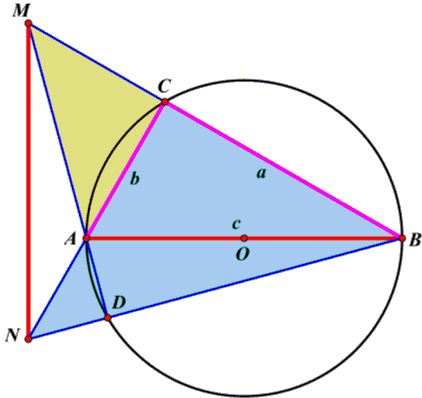A Proof of the Pythagorean Theorem with Orthocenter and Right Isosceles Triangles
Quang Tuan Bui
ABC is a triangle right at C with sides a, b, c and circumcircle (O) centered at O, the midpoint of the hypotenuse AB. Suppose
Construct point M on the ray BC such that

The intersection N of AC and BD is on the ray BD and is outside the segment BD. Therefore:
Area(ΔBMN) = Area(ΔMNA) + Area(ΔCNB) + Area(ΔCMA)
Area(ΔBMN) - Area(ΔMNA) = Area(ΔCNB) + Area(ΔCMA)
It follows that A is the orthocenter of ΔBMN, implying
| (1) | AB·MN/2 = Area(ΔCNB) + Area(ΔCMA). |
ΔMCA is right isosceles suh that triangles NDA, NCB, MDB are also right isosceles.
Two right triangles CMN and CAB are congruent (because CM = CA, CN = CB) therefore
c²/2 = Area(ΔCNB) + Area(ΔCMA)
c²/2 = a²/2 + b²/2
c² = a² + b².
which is the Pythagorean identity.
The Orthocenter
- Count the Orthocenters
- Distance between the Orthocenter and Circumcenter
- Circles through the Orthocenter
- Reflections of the Orthocenter
- CTK Wiki Math - Geometry - Reflections of the Orthocenter
- Orthocenter and Three Equal Circles
- A Proof of the Pythagorean theorem with Orthocenter and Right Isosceles Triangles
- Reflections of a Line Through the Orthocenter
- Equal Circles, Medial Triangle and Orthocenter
- All About Altitudes
- Orthocenters of Two Triangles Sharing Circumcenter and Base
- Construction of a Triangle from Circumcenter, Orthocenter and Incenter
- Reflections of the Orthocenter II
- Circles On Cevians
|Contact| |Front page| |Contents| |Geometry| |Pythagorean theorem|
Copyright © 1996-2018 Alexander Bogomolny73563066
